(9759 products available)






























































































































































































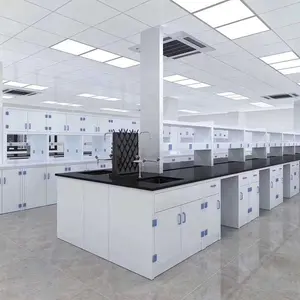
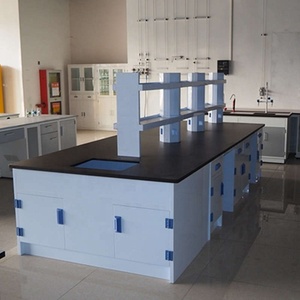
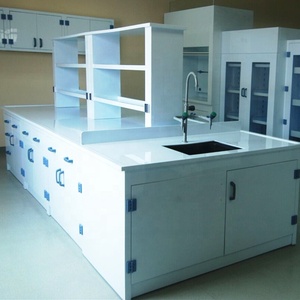
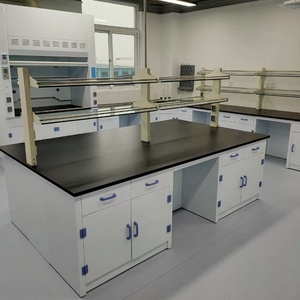
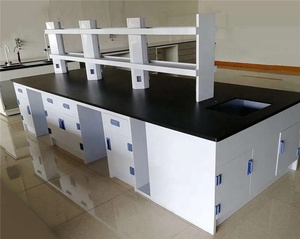
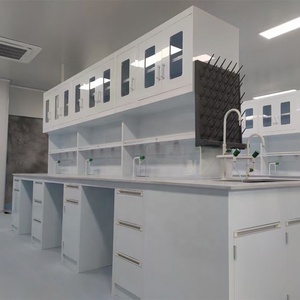






Lab workbenches are used in various laboratories. Each type is designed for specific tasks and requirements. Here are some common types:
Standard Lab Workbench
This is a multipurpose workbench. It has a simple design with a flat surface. It is used in various labs like educational, medical, and research labs. The surface is made of durable materials. These include laminate, stainless steel, or epoxy resin. It may have drawers and cabinets for storage. It provides a stable surface for experiments, sample testing, and data analysis.
Heavy-Duty Lab Workbench
This workbench is designed to handle heavy loads. It is suitable for industrial or engineering labs. The bench has a robust construction. It is made of materials like steel or high-density laminate. It is reinforced to prevent bending or breaking. The surface is usually scratch-resistant and chemical-resistant. It is ideal for using large instruments, tools, or heavy equipment. It requires minimal maintenance and is long-lasting.
Adjustable Lab Workbench
The adjustable lab workbench is versatile and ergonomic. It is designed to cater to different tasks and user preferences. The height of the bench is adjustable. Users can customize it to fit their comfort and requirements. Some models have a tilt surface. This makes it easier to work on specific tasks. The benches are suitable for various types of labs. They enhance productivity and reduce strain injuries.
Specialized Lab Workbench
These workbenches are tailored for specific tasks. For example, a chemistry lab workbench is designed for chemistry work. It has built-in storage for chemicals and a waterproof surface. Microbiology workbenches have sterile surfaces. They are used in labs that require specialized equipment. The workbenches improve efficiency. They ensure that the specific needs of the lab are met.
Collaborative Lab Workbench
This workbench encourages teamwork and collaboration. It has a large surface area. Several people can work on it at the same time. The bench is designed with integrated technology. For example, power outlets, data ports, and storage solutions. It is suitable for open-concept labs. It promotes communication and idea sharing.
Mobile Lab Workbench
The mobile lab workbench is lightweight. It has lockable casters. This makes it easy to move from one place to another. It is flexible and adaptable. Users can reposition it to suit different tasks and lab layouts. The mobile workbench is useful in dynamic lab environments. It maximizes space and improves workflow.
Lab workbenches are important in laboratories. They provide a safe and effective working environment for scientists. Here are some key features and functions of lab workbenches.
Durable Surface
Lab workbenches are made with strong materials. This can be epoxy resin, stainless steel, or phenolic resin. These materials are resistant to stains, impacts, and chemicals. The durable surface makes sure that it can withstand daily usage in the lab. It also provides a safe working environment for scientists.
Workbench Storage
Lab workbenches come with storage space. This includes shelves, drawers, and cabinets. The storage space is important for organizing lab tools and equipment. It helps in keeping the workspace neat and clean. Some workbenches have custom storage solutions. These make sure that they fit specific requirements and needs of the lab.
Adjustable Height
Some lab workbenches have adjustable height options. This allows users to change the height of the workbench. It makes sure that it is comfortable for different tasks. The adjustable height feature is also important for meeting the ergonomic requirements. This reduces the risk of strain or injury when working for long hours.
Electrical Outlets
Most lab workbenches come with built-in electrical outlets. These make it easy to power electronic devices and laboratory equipment. The electrical outlets help in reducing the need for extension cords. This feature increases safety and minimizes clutter.
Easy-to-Clean Surface
The surfaces of lab workbenches are easy to clean. This helps in maintaining hygiene and cleanliness in the laboratory. Regular cleaning removes dirt, stains, and spills that accumulate over time. The easy-to-clean surface also makes sure that the lab workspace is safe and presentable.
Modular Design
Many lab workbenches have a modular design. This means that they can be easily customized and reconfigured. It allows the lab workbench to fit different laboratory layouts and requirements. The modular design makes sure that the lab space is used effectively.
Integrated Sinks
Some lab workbenches have integrated sinks. These make it easy to clean tools and instruments. The sinks come with running water. They help in carrying out experiments that require water. It increases the efficiency of tasks that are done on the workbench.
Lab workstations are integral components of laboratory environments across various industries and fields of study. Their usage spans a wide range of scenarios, including:
Scientific Research
Lab workstations are used in scientific research to conduct experiments, analyze samples, and record data. They provide organized space for researchers to work on projects in biology, chemistry, physics, and other scientific disciplines.
Medical Laboratories
In medical labs, workstations are essential for processing patient samples, conducting tests, and analyzing results. They help ensure accurate diagnostics and efficient workflow in clinical settings.
Education
Educational institutions use lab workstations in classrooms and laboratories to teach students about various scientific concepts and experiments. These workstations are designed to be safe and user-friendly for students at all levels.
Manufacturing and Quality Control
In manufacturing environments, lab workstations are used for quality control testing, product development, and materials analysis. They help ensure that products meet industry standards and specifications before they are released to the market.
Pharmaceuticals
Pharmaceutical companies rely on lab workstations for drug discovery, development, and testing. These workstations are equipped with specialized tools and technology for high-throughput screening, compound analysis, and clinical trial preparation.
Environmental Testing
Environmental laboratories utilize workstations to analyze air, water, soil, and biological samples for contaminants and pollutants. These workstations play a crucial role in environmental monitoring and conservation efforts.
Forensics
Forensic labs employ workstations for crime scene investigation, evidence analysis, and DNA profiling. These workstations are designed to handle sensitive and confidential information, as well as hazardous materials.
Clinical Research
In clinical research settings, lab workstations are used to conduct trials, analyze patient data, and compile reports. They provide a structured environment for researchers to follow protocols and guidelines.
Microbiology
Microbiology labs utilize workstations for culturing, staining, and analyzing microorganisms. These workstations are equipped with microscopes, incubators, and sterile storage areas.
General Laboratory Work
In addition to the specialized uses mentioned above, lab workstations are also used for general laboratory tasks, such as preparing samples, cleaning instruments, and organizing supplies.
When searching for the right lab workbench, it is important to consider several factors before making any purchase. Here are some of them:
Purpose and Type of Work
The primary purpose of a lab workbench is to support specific tasks and activities. Therefore, it is important to choose a workbench designed for specific tasks such as research, testing, or sample preparation. Additionally, it is important to consider the type of work to be done on the bench. Different types of work require different features. For instance, a clinical lab may require a workbench with storage cabinets and drawers for easy access to supplies and samples. On the other hand, a cleanroom may require an anti-microbial lab table that is easy to sanitize.
Space Availability
The available space in the laboratory is a key factor when choosing a lab workbench. This is because it will determine if a large, mobile, or compact workbench will be purchased. For smaller labs, a foldable or expandable workbench may be a good option as it will help maximize space. Additionally, workbenches on wheels may be moved around the lab easily to create space when necessary.
Materials
Lab workbenches are made of different materials. The most common ones include: laminate, steel, hardwood, and stainless steel. Materials directly influence the lifespan of the workbench. As such, it is important to consider the lab activities when choosing a material. For example, a highly corrosive lab may require a stainless steel lab bench, whereas a lab with little to no water spills may use a laminate-made workbench.
Storage Capabilities
Some workbenches come with built-in storage solutions such as shelves and drawers. When choosing such a workbench, it is important to ensure that the storage space provided will meet the laboratory's needs. More importantly, consider the type of storage. Some workstations have lockable storage spaces that provide security to sensitive items.
Customization Options
Some suppliers offer customization options that allow buyers to choose the desired features of the lab workbench. When choosing a lab workbench, it is important to consider the optional accessories that come with the workbench, such as lighting and power outlets. Lighting helps improve visibility, while power outlets support electrical devices.
Q1: What is the difference between a lab workbench and a lab countertop?
A1: A lab workbench is the same as a lab workstation. It refers to a working area where scientists conduct experiments, mostly with built-in storage and drawers. A lab countertop is the surface of a lab workbench. It should be durable and chemical-resistant since it is where most experiments are conducted.
Q2: What makes a good lab workbench?
A2: A good lab workbench should have sturdy and durable construction. It should also have a functional design that allows scientists to do their work efficiently. The best lab workbenches also have adjustable heights to cater to different users and meet various laboratory requirements.
Q3: What are the main types of lab workbenches?
A3: There are three main types of lab workbenches. These include:
Q4: What are the common materials used to make lab workbenches?
A4: Lab workbenches are made from different materials. The most common materials include wood, steel, and metal. Some high-end workbenches are made of engineered wood, which offers extra durability.
Q5: Are lab workbenches easy to assemble?
A5: Most lab workbenches come fully assembled. However, some models, especially the adjustable ones, may need to be assembled upon delivery. Assembling a lab workbench is usually straightforward because the parts are labeled, and the instruction guide is also easy to follow.